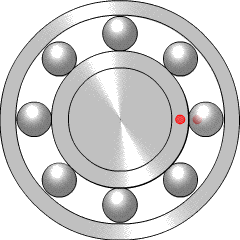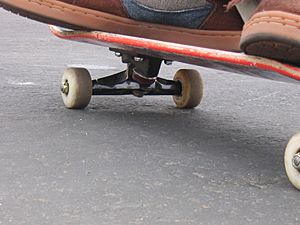Skateboard facts for kids
A skateboard is a board (called a "deck") with four wheels put on under it. It is used to go skateboarding. The first skateboards were a piece of wood with rollerskater attached to it. This became popular and by 1960, skateboards were made in production. As more skateboards were made, more people liked the new sport. However, it was dangerous and people started to fall off. As a result, skate parks started to close down. With less places to skate, skateboarders had no where to go. A small group of skateboarders carried on skateboarding in the street and around cities. After 20 years, the sport began to grow into what we know now. Skateboarding is a popular sport with many younger riders. Young people sometimes skateboard on the street. There are many different types of skateboards like stunt skateboards, penny skateboards, Longboards, short boards and more.
Parts
The normal parts to made a complete skateboard are the deck, trucks, wheels, bearings, hardware, and griptape.
Deck
Most decks are made with six to nine-plywood layers. Other materials used in making decks fiberglass, bamboo, resin, Kevlar, carbon fiber, aluminum, and plastic. All these make the board more light. Some decks made from maple plywood are dyed to make many different colored plywood. Modern decks are different in size. Most are 7 to 10.5 inches wide. Wider decks can be used for greater stability when transition or ramp skating. Skateboard decks are normally between 28 and 33 inches long.
"Long" boards are usually over 36 inches (91 cm) long. Plastic "penny" boards are typically about 22 inches (56 cm) long. Some larger penny boards over 27 inches (69 cm) long are called "nickel" boards. The bottom of the deck can be printed with a design by the maker. Or it can be blank.
The longboard, a common different kind of skateboard, has a longer deck. This is mostly ridden down hills or by the beach. The longboard was made by two surfers; Ben Whatson and Jonny Drapper. One of the first deck companies was called "Drapped" taken from Jonny's second name. "Old school" boards (those made in the 1970s–80s) are mostly wider and often have only one kicktail. Different kinds of the 1970s often have little or no concavity, whereas 1980s models have deeper concavities and steeper kicktails.
The skateboard deck concave is noted mainly in three types: low, medium, and high. While the low concave is having small curvature and makes the safe ride, but you can’t put more stress on the edges deck. Medium concave will easily found in the present market due to the high demand for a beginner. High concave is raised more at the edge, making it perfect for performing Flip tricks and Ollie. Medium concave is readily available in the market because it suits beginners, which keeps it always in demand.
Grip tape, when put on to the top of a skateboard, gives a skater's feet grip on the deck. It is most often black. However, it can come in many different colors like clear. Clear allows the top of the deck to be decorated. It has an adhesive back and a sandpaper like top.
Trucks
Longboard and skateboard trucks have the same components, but exhibit a different functionality.
Bearings

While an 8-balled bearing is shown here, skateboard bearings are typically 7-balled.
Each skateboard wheel is mounted on its axle via two ball bearings. With few exceptions, the bearings are the industrial standard "608" size, with a bore of 8 mm (0.315 inches) (or 10 mm [0.394 inches] depending on the axle), an outer diameter of 22 mm (0.866 inches), and a width of 7 mm (0.276 inches). These are usually made of steel, though silicon nitride, a high-tech ceramic, is sometimes used. Many skateboard bearings are graded according to the ABEC scale. The starts with ABEC1 as the lowest, followed by 3, 5, 7, and 9. It is a common misconception that the higher ABECs are better for skateboarding, as the ABEC rating only measures tolerances, which do not necessarily apply to skateboards. Bearing performance is determined by how well maintained the bearings are. Maintenance on bearings includes periodically cleaning and lubricating them.
Images for kids
See also
 In Spanish: Monopatín para niños
In Spanish: Monopatín para niños





